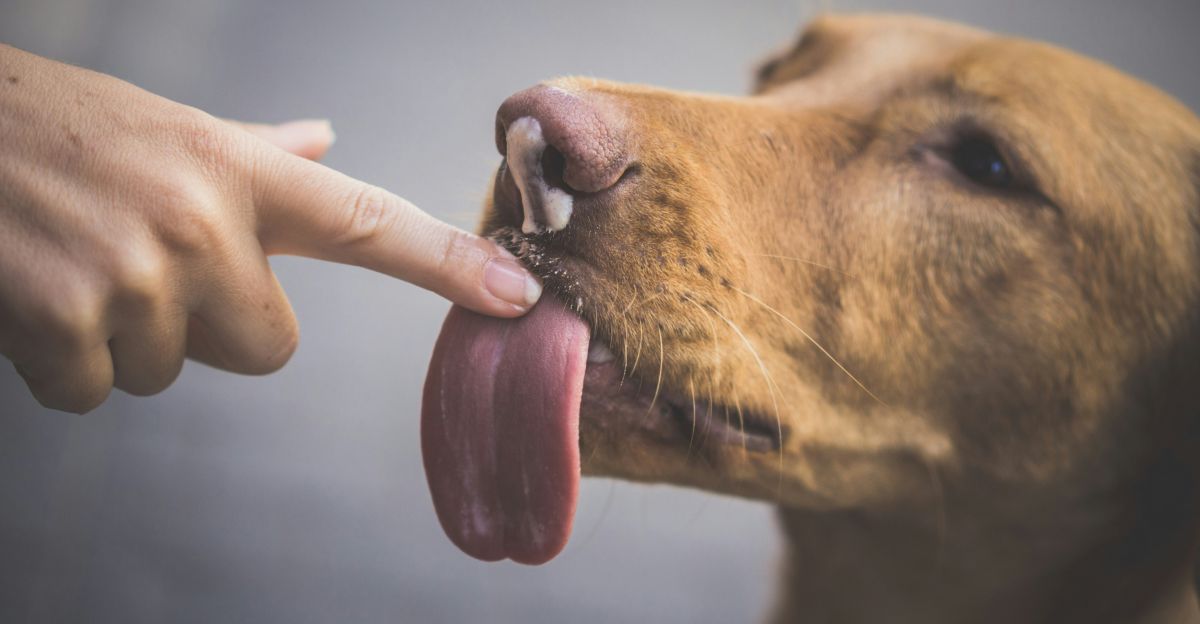Why Does My Dog Groom Me? A Guide to Your Dog’s Licks, Nibbles, and Nuzzles

Have you ever been relaxing on the couch, only to have your furry best friend start meticulously licking your hand? Or maybe you’ve experienced the strange, ticklish sensation of your dog gently nibbling your arm with their front teeth. These moments often leave us wondering, "Why does my dog groom me?"
While it’s easy to label every lick a "doggy kiss," you're right to suspect there's more to the story. These grooming behaviors are a complex and fascinating part of how dogs communicate. They’re talking to you—and learning to understand their language can deepen your bond in incredible ways.
So, let's dive into the adorable mystery and answer the question: why do dogs lick their owners?
It’s All About Love: Affection and Social Bonding
At its heart, one of the most common reasons your dog grooms you is to show affection. This behavior is deeply instinctual, tracing all the way back to puppyhood. A mother dog licks her puppies constantly to clean them, comfort them, and stimulate them to go to the bathroom. This first experience creates a powerful, lifelong association between licking and feelings of safety, care, and love.
When your dog licks or gently nibbles you, they are often recreating that nurturing behavior. They see you as a cherished member of their pack or family. In the wild, wolves and dogs groom each other to strengthen social bonds and maintain pack harmony. So when your dog grooms you, it’s their way of saying, "You're one of us, and I care about you."
The act itself is also biochemically rewarding for your dog, releasing pleasure-inducing endorphins and dopamine that make them feel happy and relaxed.
"Can I Have Your Attention?" Grooming as Communication
Dogs can't use words, so they use their bodies to communicate their needs and desires. A persistent lick on your hand or a nudge with their nose can be a very direct message.
Your dog might be trying to tell you:
● "I'm hungry!"
● "It's time for our walk!"
● "Please don't stop petting me!"
● "Let's play!"
Paying attention to the context is key. If the licking starts around dinnertime or near the treat jar, you can bet it's a request for food.
You Just Taste Good!
Let's be honest—sometimes the answer to "why does my dog lick me?" is simply because you taste interesting! A dog's senses of taste and smell are far more powerful than ours, and our skin can be a fascinating sensory experience for them.
They might be drawn to:
● The salt on your skin: Especially after you've been sweating from a workout.
● Tiny food particles: Left on your hands or face after a meal.
● Lotions and creams: Many topical products have scents and flavors that dogs find appealing.
A Quick Word of Caution: While it might seem harmless, you should never let your dog lick skin where you've applied medicated creams or certain lotions. Products containing ingredients like zinc oxide (common in diaper rash creams and sunscreens) or various prescription medications can be toxic if ingested by your dog. Always keep these products stored safely and prevent your dog from licking treated areas.
A Living Pacifier: Grooming for Stress Relief
Just like humans might bite their nails or twirl their hair when nervous, dogs use licking as a self-soothing mechanism. The repetitive motion helps them calm down when they feel stressed, anxious, or even just bored. This is especially common in dogs with separation anxiety, who may lick obsessively before you leave or while you're gone.
Dogs are also incredibly empathetic. They are highly attuned to our emotions and may try to groom you if you're crying or upset. A 2012 study found that dogs were more likely to approach and nuzzle their owners when they were pretending to cry, suggesting they are trying to offer comfort.
When Grooming Becomes a Concern
While licking is a normal behavior, it can sometimes become excessive or compulsive, signaling an underlying problem. If you notice your dog's grooming has become obsessive, it's time to pay closer attention.
Signs of problematic grooming include:
● Physical damage: Hair loss, bald patches, red or inflamed skin ("hot spots"), or sores.
● Constant licking: The dog seems unable to stop, even when it interrupts sleep or play.
● Signs of pain: Whimpering or moaning while grooming a specific area.
If you see these signs, the first and most important step is to visit your veterinarian. Excessive grooming is often caused by medical issues that need treatment, such as:
● Allergies: To food or environmental triggers like pollen.
● Pain: From arthritis, an injury, or a wound.
● Parasites: Like fleas or mites.
● Skin infections: Bacterial or yeast infections can be very itchy.
If your vet rules out medical causes, the issue may be behavioral, like severe anxiety or a compulsive disorder, which may require help from a professional animal behaviorist.
The Final Lick
So, why does my dog groom me? It's a rich, complex language of love, communication, and instinct. Whether they're giving you an affectionate "doggy kiss," asking for dinner, or trying to soothe their own anxiety, their grooming behaviors are a window into their world.
By learning to interpret these signals, you can better understand your dog's needs, strengthen your bond, and ensure they are happy and healthy.
What's your dog's favorite way to groom you? Share your stories in the comments below!


